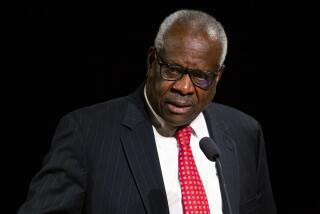Risk of Nuclear War Can Be Cut, Despite Soviets
The news from Geneva, where American and Soviet representatives resumed nuclear talks last Thursday after a six-week recess, is not good.
The Soviets still insist that unless Washington agrees to a total abandonment of President Reagan’s “Star Wars” program, including research that is permissible under the 1972 agreement limiting anti-missile defense systems, serious talks on a reduction of offensive nuclear forces cannot take place. The Administration justifiably rejects this all-or-nothing demand, but less justifiably refuses to put Star Wars on the bargaining table at all.
The logjam may break when and if Reagan and Soviet leader Mikhail S. Gorbachev meet in the fall. But a total breakdown of the Geneva talks later this year cannot be excluded.
This is unfortunate. But it’s worth considering the point made in a new study from Harvard: that while nuclear-arms-reduction talks are an eminently worthwhile pursuit, they are but one element in an intelligent program for reducing the chances of nuclear war.
The principal authors of the study, which is being published in book form this month, are Graham T. Allison, dean of the Kennedy School of Government; Prof. Joseph S. Nye Jr., a former deputy undersecretary of state, and Albert Carnesale, academic dean of the Kennedy School and a veteran of the SALT I negotiations.
In addition to inviting input from several leading scholars around the country, the Harvard team conducted interviews with top U.S. officials, past and present, as well as with well-placed Soviet sources. It remains to be seen whether the study has any effect on policy-makers, but hearings on the group’s recommendations will be held in mid-June by Rep. Les Aspin (D-Wis.), chairman of the House Armed Services Committee.
Two decades ago British scientist-novelist C. P. Snow called nuclear war a “mathematical certainty” within 10 years. He was wrong, but there is no question that fear of nuclear war has grown in recent years. In their book, entitled “Hawks, Doves & Owls,” the Harvard group notes that nearly half the public says that nuclear war is likely before the end of the century.
Specialists in national security are more optimistic: They put the grisly odds at somewhere between one in 100 and one in 10,000. Given the horrible consequences of a nuclear war, the authors agree that this is small comfort. They assert that the avoidance of nuclear war must be the overriding purpose of American national-security policy, and that we cannot afford to wait for negotiated solutions.
To begin with, such negotiations tend to be protracted but disappointingly short on practical results. Beyond that, as Allison said in Los Angeles last week, “If we woke up tomorrow and found that nuclear arms had been cut in half . . . the remaining weapons would still be more than enough to lead to a nuclear holocaust.”
All too often concern over the danger of nuclear war degenerates into handwringing or simple-minded pressures for unilateral concessions to the very tough crowd that runs the Kremlin. It’s refreshing to see some positive, realistic proposals.
The Harvard team, impatient with the polarized debate between hawks and doves on nuclear issues, lays out a middle-ground “owl” agenda of “things we can do now” to reduce the chances of nuclear war. Much of the debate over nuclear policy revolves around the assumption that the Soviets might decide some Monday morning to launch a surprise attack on America. Almost all experts agree, however, that this is the least likely scenario.
Novels and movies of the 1960s, such as “Fail-Safe” and “Dr. Strangelove,” dramatized another possibility: the danger of “accidental” nuclear war brought on by faulty radar signals or a subordinate commander gone amok. And it could happen.
Among people who make their living thinking about such things, however, the most likely scenario for nuclear war is escalation from a non-nuclear collision of the Great Powers in one part of the world or another (possibly egged on by Third World client countries) with events running out of control by the political leadership in Moscow and Washington.
The list of precautionary do’s and don’ts offered by the Harvard trio, including warnings against a nuclear freeze on the one hand and provocative behavior toward the Soviet Union on the other, will not please the ideologues of left or right. Nor are they especially dramatic. But that is often the case with common sense.
Some of the prescriptions actually are being pursued already, which is one reason that experts are more sanguine than are uninformed citizens about the danger of nuclear war. Examples include the call for better “hot-line” communications, avoidance of large-scale maneuvers or troop movements by both sides at the same time, efforts to avoid the further spread of nuclear weapons in the world, and the improvement of conventional, non-nuclear forces to avoid early reliance on the use of nuclear weapons to stop a conventional Soviet attack in Europe or the Middle East.
But the Harvard group also recommends against building weapons primarily for use as bargaining chips, a favorite Pentagon ploy to win approval of new weapon systems. The team urges that political contacts not be restricted in retaliation for Soviet misbehavior, as President Jimmy Carter did after the 1979 Soviet invasion of Afghanistan. And it warns even more strongly against the employment of nuclear alerts to send political signals to the Kremlin, as President Richard M. Nixon did during the 1973 Middle East crisis. It’s too dangerous.
The study urges Presidents not to exaggerate military imbalances, as Reagan and his defense secretary have done repeatedly. And it makes the seemingly obvious proposal that top leaders prepare themselves to deal with the mind-numbing possibility of a for-real nuclear crisis. Carter, it seems, is the only recent President who bothered to do his homework; the others have preferred not to think about the unthinkable.
Progress at Geneva presumably would contribute to a healthier, less accident-prone relationship between the two great powers. The nice thing about the list of do’s and don’ts proffered by Nye, Carnesale and Allison, however, is that most of the proposals can and should be implemented--regardless of what happens in Geneva.
More to Read
Start your day right
Sign up for Essential California for news, features and recommendations from the L.A. Times and beyond in your inbox six days a week.
You may occasionally receive promotional content from the Los Angeles Times.






